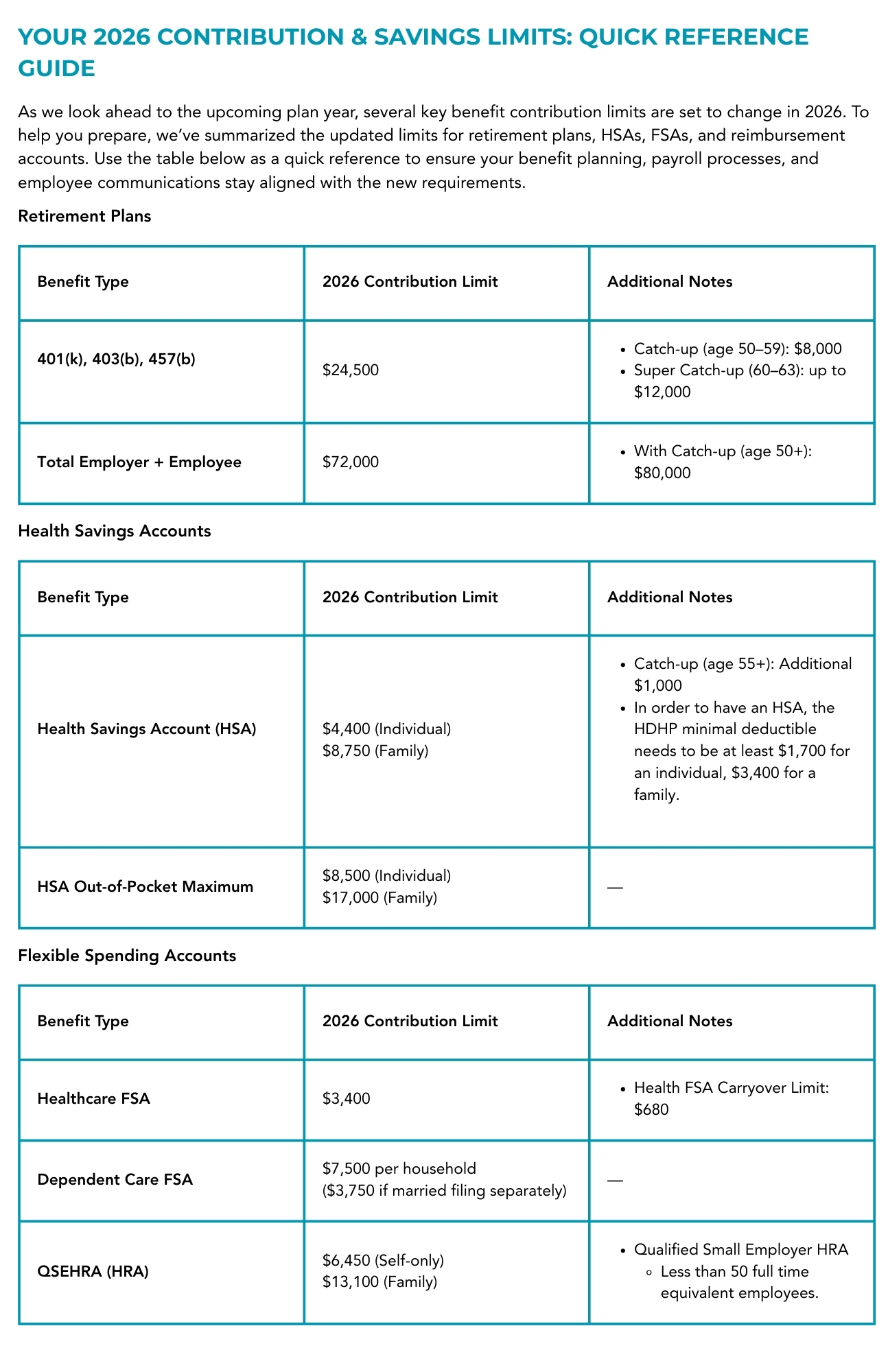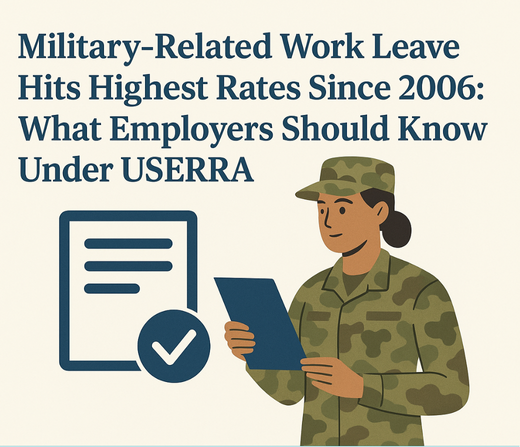
Category: blog
SECURE 2.0: What Plan Sponsors Need to Know About Upcoming Roth Catch-Up Rules

We want to inform you about an important change to retirement plan catch-up contributions that will take effect on January 1, 2026, as part of the SECURE 2.0 Act.
What’s Changing?
Beginning in 2026, participants that are age 50 or older and earned more than $145,000 in FICA wages in the previous calendar year will be required to make any catch-up contributions as Roth (after-tax) contributions. This rule applies to all 401(k), 403(b), and governmental 457(b) plans.
Key Details:
- FICA wages include salary, tips, bonuses, commissions, and taxable fringe benefits (Box 3 on your W-2).
- The $145,000 threshold is indexed annually for inflation.
- If your plan does not offer Roth contributions, plan participants will not be able/eligible to make catch-up contributions if they exceed the wage threshold.
- New limits for ages 60–63: Starting in 2025, participants in this age group may contribute an additional $3,750 super catch up contribution (indexed), which must also be Roth if the wage threshold is met.
What You Need to Do:
- Ensure your plan offers a Roth contribution option.
- Coordinate with payroll providers and the plan’s record keeper to identify impacted participants and adjust contribution processing.
- Review your employees’ 2025 earnings to determine which participants may be impacted.
- Check your plan’s salary deferral election options and help any impacted participants update their elections if necessary.
- Have participants contact the plan’s financial professional to understand how Roth contributions may affect their retirement strategy.
- Educate employees about the upcoming changes and provide support for updating elections.
Changes for Long-Term Part-Time Participants:
- Effective January 1, 2025, LTPT employees must have worked at least 500 hours in each of two consecutive 12-month periods.
- Employees must be 21 years of age or older.
- Service prior to January 1, 2021 (for 401(k) plans) and January 1, 2023 (for 403(b) plans) is excluded from eligibility and vesting calculations.
- These changes are designed to expand retirement savings opportunities for part-time workers who have demonstrated long-term commitment to their employers.
What LTPT Employees Are Eligible For:
- Elective salary deferrals to the retirement plan.
- Employer contributions (matching or non-elective) are optional and at the discretion of the plan sponsor.
- Vesting begins once the employee satisfies the LTPT eligibility criteria, with one year of vesting credit for each year of 500+ hours of service.
Plan Sponsor Considerations:
- Track hours accurately for part-time employees to determine eligibility.
- Decide whether to include LTPT employees in employer contributions and nondiscrimination testing.
Reach out to us at [email protected] to learn more.
Using AI in the Workplace: Why Employers Need Clear Policies, Procedures & Training

Policies, Procedures & Appropriate Use
- Employers should establish a formal AI policy outlining approved tools, acceptable use, and consequences for misuse.
- Amazon now requires some employees to demonstrate AI use to qualify for promotions, showing how quickly expectations around AI are evolving.
- Policies should also explain when AI is appropriate (drafting communications, summarizing information, creating first drafts, etc.) and when it isn’t, such as making final hiring decisions or handling confidential or sensitive data.
- With 42% of workers using AI secretly (“shadow AI”), unclear policies often push employees toward unmonitored usage.
- Mandatory human review of all AI-generated content, especially for sensitive or business-critical areas should be implemented as part of these policies.
Training, Responsible Use & Data Restrictions
- Employees must be trained on how AI works, where it’s reliable, its limitations, and potential accuracy or bias concerns.
- The U.S. Department of Labor recommends training employees to ensure AI is deployed safely and equitably at work.
- Accenture’s CEO reinforces that AI adoption must be paired with strong governance and ongoing employee training.
- Policies should explicitly prohibit entering proprietary, personal, financial, or customer information into public AI tools unless approved.
- Many organizations ban uploading confidential information into open AI platforms to prevent privacy or compliance risks.
Approved Platforms & Security Oversight
- Employers should clearly define which AI tools are approved, and set a review process for requesting new platforms.
- Best practices include choosing vendors that do not use company input data to train public models.
- IT and cybersecurity teams must vet AI systems for data retention, privacy practices, and overall security before approval.
- Real-world guidance emphasizes the need for regular audits and security reviews to ensure platforms remain compliant.
Moving Forward Responsibly
As AI becomes a standard workplace tool, responsible implementation is no longer optional, but strategic. Organizations that set clear expectations, provide effective training, and invest in secure, vetted AI systems will mitigate risk while empowering employees to work smarter and more efficiently. Thoughtful policies today lay the foundation for safe, ethical, and innovative use of AI tomorrow.
To learn more or get help developing a customized workplace AI policy, contact [email protected].
New Hampshire Employers: Prepare Now for New Unpaid Parental Leave Law
 Beginning January 1, 2026, New Hampshire will require covered employers to offer unpaid parental leave for certain birth- and infant-related medical appointments.
Beginning January 1, 2026, New Hampshire will require covered employers to offer unpaid parental leave for certain birth- and infant-related medical appointments.
What the Law Requires
- Employers with 20 or more employees must allow eligible staff to take up to 25 hours of unpaid leave during the first year after a child’s birth or adoption.
- This leave may be used for:
- The employee’s own childbirth or postpartum medical care
- Pediatric medical appointments for the child
- If both parents work for the same employer, they must share the 25-hour entitlement (i.e. combined, not 25 hours each).
Eligibility, Notice & Documentation
- The law applies to full-time and part-time employees, but not seasonal or temporary workers.
- Employees must give reasonable advance notice and make efforts to minimize disruption.
- Employers may request reasonable documentation (e.g. a medical note) to verify the leave.
Paid Time Substitution & Salaried Employees
- Though the leave is unpaid, employees may opt to substitute accrued paid leave (vacation, sick, etc.) for part or all of it.
- For salaried (exempt) employees, employers generally cannot deduct pay for missed days under leave laws, unless specifically allowed under statute.
Job Protection & Related Laws
- Upon return, employees must be reinstated to their original (or equivalent) positions.
- Employers should also keep in mind:
- The nursing-mothers accommodation law effective July 1, 2025 (requires breaks and lactation space)
- Existing maternity leave statutes
- The state’s voluntary Paid Family & Medical Leave (NH PFML) program
Action Steps for Employers
- Review and update your leave policies to include the new entitlement by January 1, 2026.
- Train HR / management on notice, documentation, and reinstatement obligations.
- Ensure record keeping and tracking mechanisms for the 25-hour leave usage.
- Confirm alignment with other leave and lactation policies.
Stay ahead of the 2026 compliance deadline. Download our New Hampshire Parental Leave Compliance Checklist to make sure your policies, documentation, and HR procedures are ready before January 1, 2026.
Source: Duane Morris
2026 HR & Business Compliance: New England Edition

As 2025 winds down, employers across New England face a wave of new HR and compliance changes. From paid leave to pay transparency and wage increases, here is a quick Q&A guide to keep your team ready for 2026.
Building on our previous national overview, here’s what HR teams across New England need to know before January 1.
What’s the biggest HR change for New England in 2026?
Maine’s Paid Family and Medical Leave (PFML) program launches May 1, 2026, offering up to 12 weeks of paid leave for family or medical reasons. Payroll contributions started January 1, 2025, so setup should begin now.
✅ Checklist:
- Register with Maine’s PFML portal and update payroll systems.
- Add PFML details to your handbook and onboarding materials.
- Post required state notices once released.
What’s New in Massachusetts?
Starting October 29, 2025, employers with 25+ employees must include pay ranges in all job postings. Those with 100+ employees must file annual pay data reports beginning in 2026.
✅ Checklist:
- Audit job postings for salary range compliance.
- Train hiring teams on disclosure requirements.
- Conduct internal pay equity reviews.
What’s Changing in Connecticut and Other Nearby States?
Connecticut’s expanded Paid Sick Leave Law takes effect January 1, 2026, covering more employers and reasons for time off. Vermont has updated its family leave rules, and Rhode Island continues expanding Temporary Caregiver Insurance coverage.
✅ Checklist:
- Update sick and family leave policies.
- Ensure time-off tracking systems reflect multi-state rules.
- Review remote work policies for cross-state employees.
Do We Need to Adjust Payroll for 2026?
Yes. All six New England states are raising minimum wages on January 1, 2026, and several are reviewing overtime eligibility thresholds.
✅ Checklist:
- Verify new wage rates for each state.
- Review exempt vs. nonexempt classifications.
- Update pay statements and offer letters.
What Else Should HR Keep an Eye On?
Expect updates to mandatory workplace postings, emerging AI and hiring transparency laws, and growing data privacy requirements for employee information.
✅ Checklist:
- Order new 2026 labor law posters.
- Review vendor compliance with AI and privacy rules.
- Schedule HR compliance training for Q1 2026.
Start 2026 with a clear compliance checklist, from handbook updates to pay transparency, leave laws, and payroll adjustments. Make sure your HR team is proactive, not reactive, in the new year.
Reach out to us at [email protected] to learn more.
Military-Related Work Leave Hits Highest Rates Since 2006: What Employers Should Know Under USERRA

Recent data from the U.S. Bureau of Labor Statistics show a sharp increase in military and civil service leave, with more than 90,000 instances of employees missing at least one week of work in the first eight months of 2025. That is nearly double last year’s figures and marks the highest rate of such leave since 2006. The uptick is largely driven by expanded deployments of National Guard personnel to cities like Washington, D.C., Los Angeles, and beyond.
Because of these trends, more employers will need to ensure compliance with the Uniformed Services Employment and Reemployment Rights Act (USERRA), a federal statute that imposes strict obligations on employers whenever employees serve in the uniformed services.
Key Obligations for Employers
- No discrimination or retaliation: Employers may not deny employment, reemployment, promotions, or benefits because an employee serves in the military.
- Leave protections and benefits continuity: Covered employees may take up to five years of military leave over their lifetime. During that time, employers must maintain their seniority, pension, and health care benefits as if the leave did not disrupt service.
- Reemployment rights: Returning service members generally are entitled to return to the job they would have held had they not served (the “escalator” principle).
- Notice and timing requirements: Employees should provide advance notice of military service, when feasible. Upon return, they must request reemployment within specified windows (e.g. next workday for brief service, up to 90 days for longer).
- Health benefits and accommodations: Employees can continue employer health coverage (up to 24 months) during service, and must be reinstated to their health plans upon return, without waiting periods or exclusions for service-related conditions.
- Restrictions on termination after return: After reemployment, returning staff cannot be terminated without cause for a period (e.g. 180 days if service was under 180 days; one year if longer).
What You Should Do Now
- Review your policies: Make sure your leave-of-absence and reemployment policies reflect USERRA’s requirements.
- Train HR and managers: Provide guidance on how to respond to military leave requests, reemployment demands, and benefit continuity.
- Document carefully: Maintain records of leave requests, notices, reemployment requests, and decisions.
- Evaluate cases for hardship exceptions cautiously: USERRA allows limited defenses (e.g. undue hardship), but courts construe them narrowly.
- Consult legal counsel: Especially since violations can carry serious liability: double damages, attorneys’ fees, and statutory penalties for knowing noncompliance.
Need help reviewing your USERRA compliance or leave policies? Contact us today at [email protected].
White House Announces Dramatic H-1B Fee Hike: What Employers Need to Know

On September 19, 2025, the White House issued a sweeping new policy: employers filing new H-1B visa petitions after September 21 must pay a $100,000 fee per petition, dramatically higher than existing costs. This bold move signals a sharp pivot in U.S. immigration enforcement, with broad implications for talent acquisition strategies.
What the Fee Change Covers — and Doesn’t
- This one-time $100,000 fee is only for new H-1B petitions, not renewals or extensions.
- It does not affect current H-1B visa holders or those whose petitions were filed before September 21, 2025.
- Applicants outside the U.S. must pay it at the time of filing, though certain case-by-case exemptions may apply in the “national interest.”
- Additional measures mandate higher prevailing wages, stricter oversight, and more rigorous compliance documentation.
Why the Increase?
The Administration frames the hike as a tool to reduce reliance on foreign talent, and push companies to hire and train U.S. workers instead. It also seeks to “upsell” the H-1B program toward only the highest skilled, highest paid foreign workers.
What Employers Should Do Now
- Reevaluate hiring plans: Consider domestic recruitment or job redesign to avoid H-1B dependence.
- Explore alternate visa pathways: Categories like O-1, EB-1, or EB-2 may remain viable—though each has its own eligibility rules.
- Document potential exemptions: If your business has national security, research, or critical STEM roles, you may qualify for relief.
- Budget early: The $100,000 outlay plus increased wages will impact cash flow and offers.
- Engage immigration counsel: With regulatory guidance and litigation likely to follow, expert counsel is essential.
If you have questions about how these changes could affect your hiring or visa planning, HR Synergy can help you navigate the new requirements and keep your business compliant.
Source: USCIS
2026 HR & Business Compliance: What You Need to Know

Staying ahead of compliance changes is critical for avoiding penalties and maintaining a healthy workplace culture.
Here is a quick Q&A to keep your team preparedfor the year ahead.
What major HR compliance changes are expected in 2026?
- Expanded Paid Family & Medical Leave (FMLA): More states may include part-time employees and longer leave periods.
- Minimum Wage & Overtime: Expect increases to state minimum wages and a higher federal salary threshold for exempt staff.
- Workplace Safety: OSHA may issue stricter emergency and hazard communication standards.
- EEO Protections: Caregivers, military personnel, and gig workers may gain protected status.
- Remote Work Legislation: States could formalize employee rights to flexible work arrangements.
- Data Privacy: New regulations may limit employee monitoring without consent.
What are the top compliance risks for employers?
- Wage Theft Liability: Laws like California’s SB 809 and SB 597 expand contractor liability.
- WARN Act Updates: Layoff planning and severance communication rules are shifting.
- Multilingual Notices: Workplace rights must be posted in multiple languages.
- Personnel Records Access: Employees may gain broader rights to inspect their files.
- ICE Raid Preparedness: Strict protocols will apply for immigration inspections.
What deadlines should businesses track in 2026?
- January 31: W-2 and 1099 filings.
- March 31: ACA electronic filing.
- April 15: Corporate tax returns.
- April 24: ADA Title II compliance for WCAG 2.1 AA digital accessibility (large entities).
- Ongoing: SEC, FINRA, and state-specific filings depending on your business type.
How can businesses prepare now?
- Conduct a compliance audit to identify gaps.
- Update employee handbooks and training materials.
- Revise leave, wage, and remote work policies.
- Ensure digital accessibility on all public platforms.
- Monitor state-specific legislation and industry trends.
Start 2026 with a clear compliance checklist — from handbook updates to pay transparency, leave laws, and payroll adjustments — so your HR team is proactive, not reactive, in the new year.
Reach out to us at [email protected] to learn more.
The Massachusetts Pay Transparency Law

Massachusetts has joined other states in mandating pay transparency by requiring pay range information in all job postings and advertisements for employers with 25 or more employees. This new law becomes effective October 29, 2025.
Who Is a Covered Employer?
The law applies to private and public employers with at least 25 employees whose primary place of work was in Massachusetts during the prior calendar year.
To determine coverage, employers must count all individuals who performed services for wages or other compensation, including full-time, part-time, and seasonal workers, whose primary place of work is in Massachusetts.
The Attorney General’s Office has adopted the definition of “primary place of work” from its Massachusetts Earned Sick Time Law guidance, which refers to the location where an employee performs the majority of their work.
Employers should also include in their count:
- Employees who telecommute to a Massachusetts worksite, even if located in another state;
- Employees who telecommute from Massachusetts to an out-of-state worksite; and
- Employees who permanently relocate to Massachusetts, starting their first day of work in the state.
Disclosure includes:
- Job Postings – All job postings and advertisements intended to recruit for a specific position must include the pay range.
- Promotions/Transfers: The pay range must be disclosed when an employee is offered a promotion or transfer to a new position.
- Upon Request: Existing employees and job applicants can request the pay range for a specific position and must receive it.
The disclosure requirement also applies to remote positions that are tied to a Massachusetts worksite and/or that can be performed by an employee located in Massachusetts.
This new law also has pay data reporting requirements for those employers that submit EEO reports to the EEOC.
Employers should begin preparing to ensure legal compliance.
Need help? Reach out to us at [email protected].
Why Onboarding Matters for Small Businesses and Nonprofits — And the Risks of Skipping Documentation

For small businesses and nonprofit organizations, every hire counts. With limited resources and lean teams, it’s tempting to let new employees jump into work quickly — sometimes even before completing all the necessary paperwork. But skipping proper onboarding steps can lead to costly compliance issues and operational headaches.
Why Onboarding Is More Than Just a First Day Welcome
A structured onboarding process helps ensure:
- Legal compliance: Federal and state laws require specific documentation (like I-9s and W-4s) to be completed before or on the first day of work. Missing these can result in fines or audits.
- Clear expectations: New hires need to understand your policies, mission, and culture from day one — especially in nonprofits where values and conduct are central.
- Payroll accuracy: Without proper tax forms, payroll errors can occur, creating frustration for employees and administrative burdens for your team.
- Risk management: Onboarding includes safety protocols, confidentiality agreements, and other protections that reduce liability.
The Risks of Starting Work Without Proper Documentation
Allowing someone to begin work before completing onboarding paperwork can expose your organization to:
- Government penalties: Incomplete I-9 forms can lead to fines ranging from hundreds to thousands of dollars per violation.
- Insurance issues: If an employee is injured before being officially documented, your workers’ comp coverage may be compromised.
- Data security concerns: Collecting personal information informally or after the fact increases the risk of mishandling sensitive data.
- Reputation damage: Nonprofits especially rely on trust and transparency. Compliance missteps can affect donor confidence and public perception.
Practical Tips for Small Teams
Even without a large HR department, you can implement a strong onboarding process:
- ✅ Use a checklist for every new hire to ensure all forms and policies are completed before work begins.
- ✅ Leverage digital tools like onboarding platforms or secure e-signature services to streamline paperwork.
- ✅ Train managers and supervisors to understand the importance of onboarding and avoid shortcuts.
- ✅ Schedule onboarding time intentionally — don’t let it get buried under daily operations.
Onboarding isn’t just a formality — it’s a safeguard. For small businesses and nonprofits, where every person plays a vital role, starting off on the right foot protects your organization and empowers your team. Taking the time to do it right isn’t a luxury — it’s a necessity.
